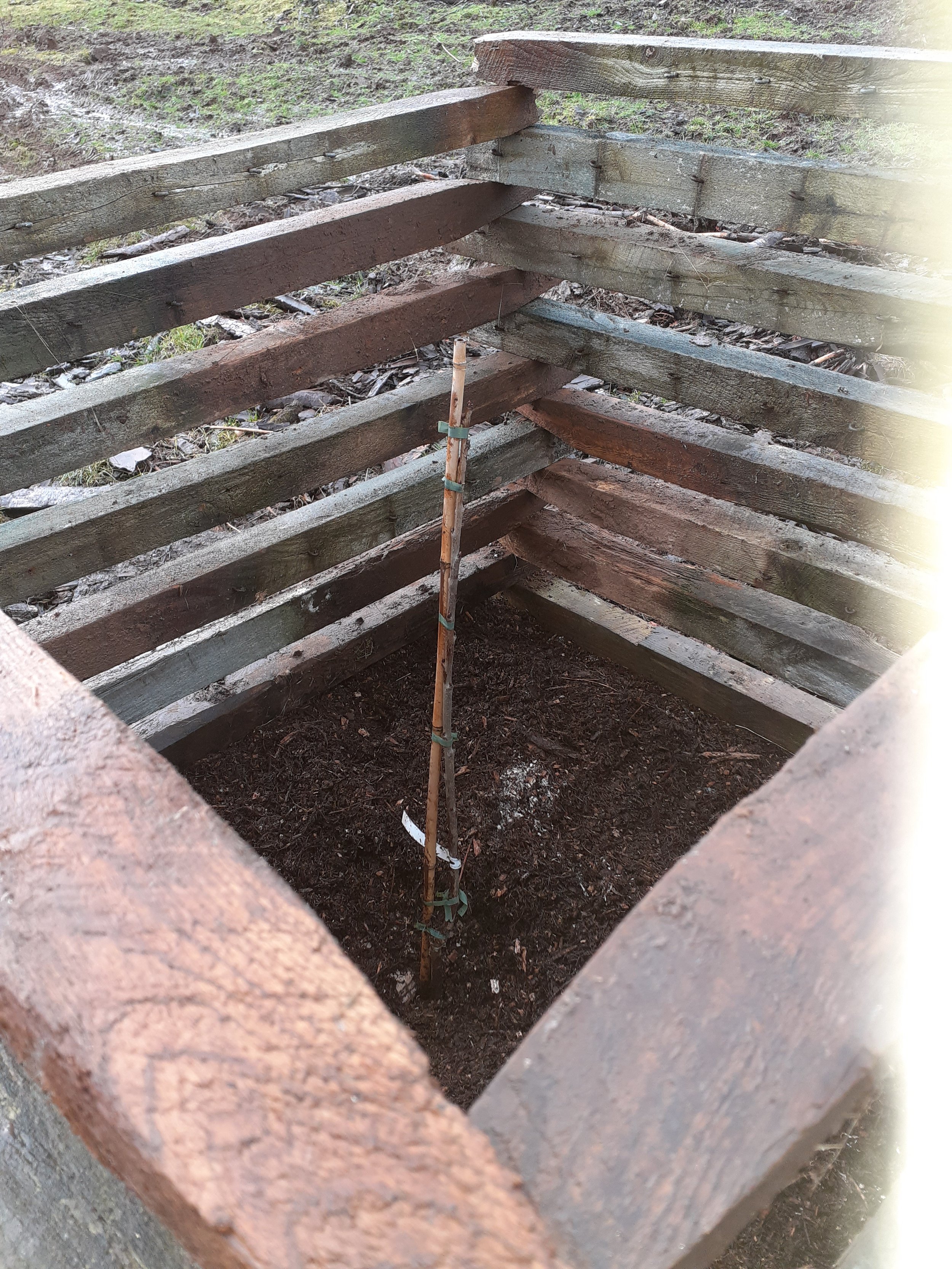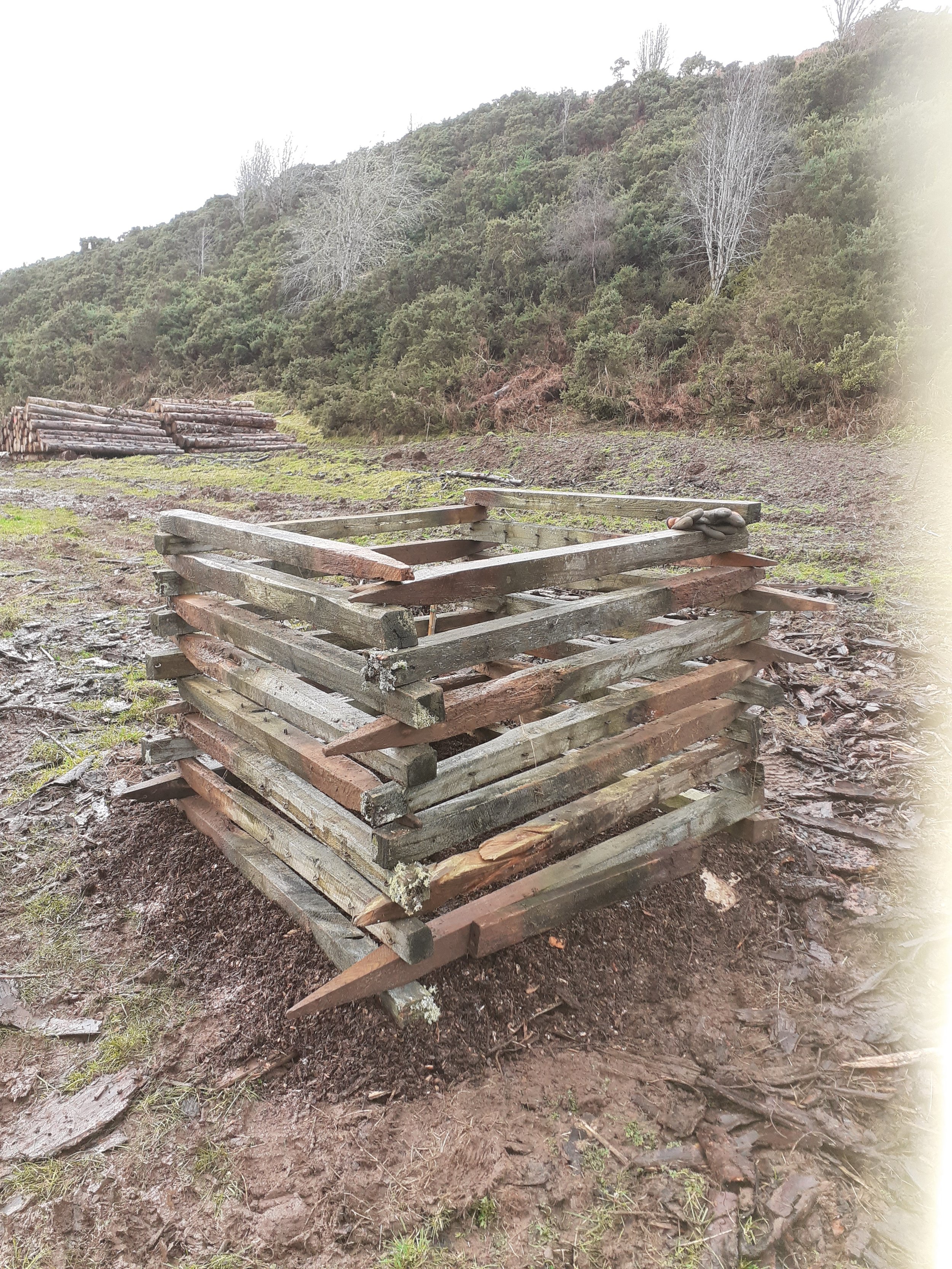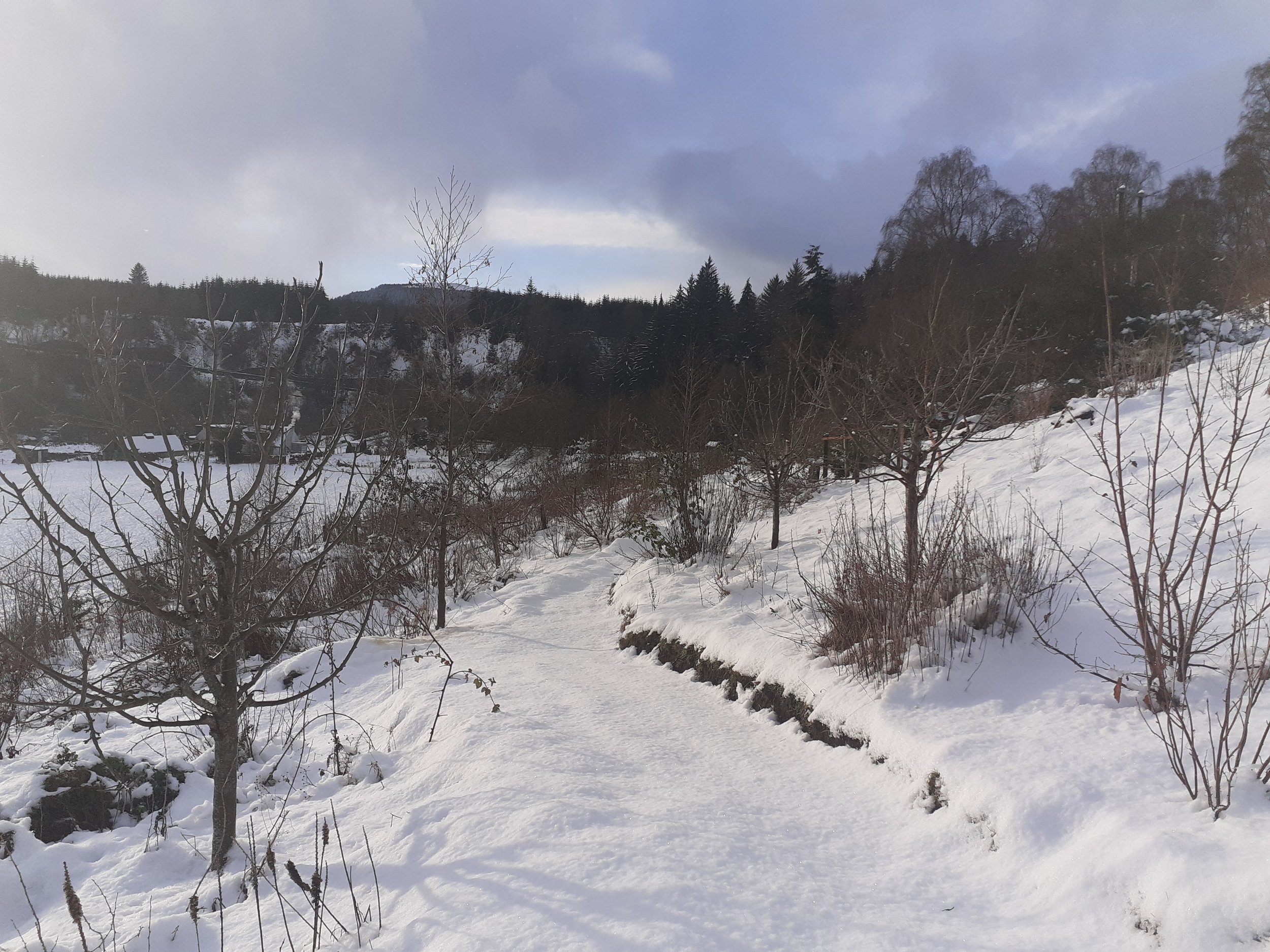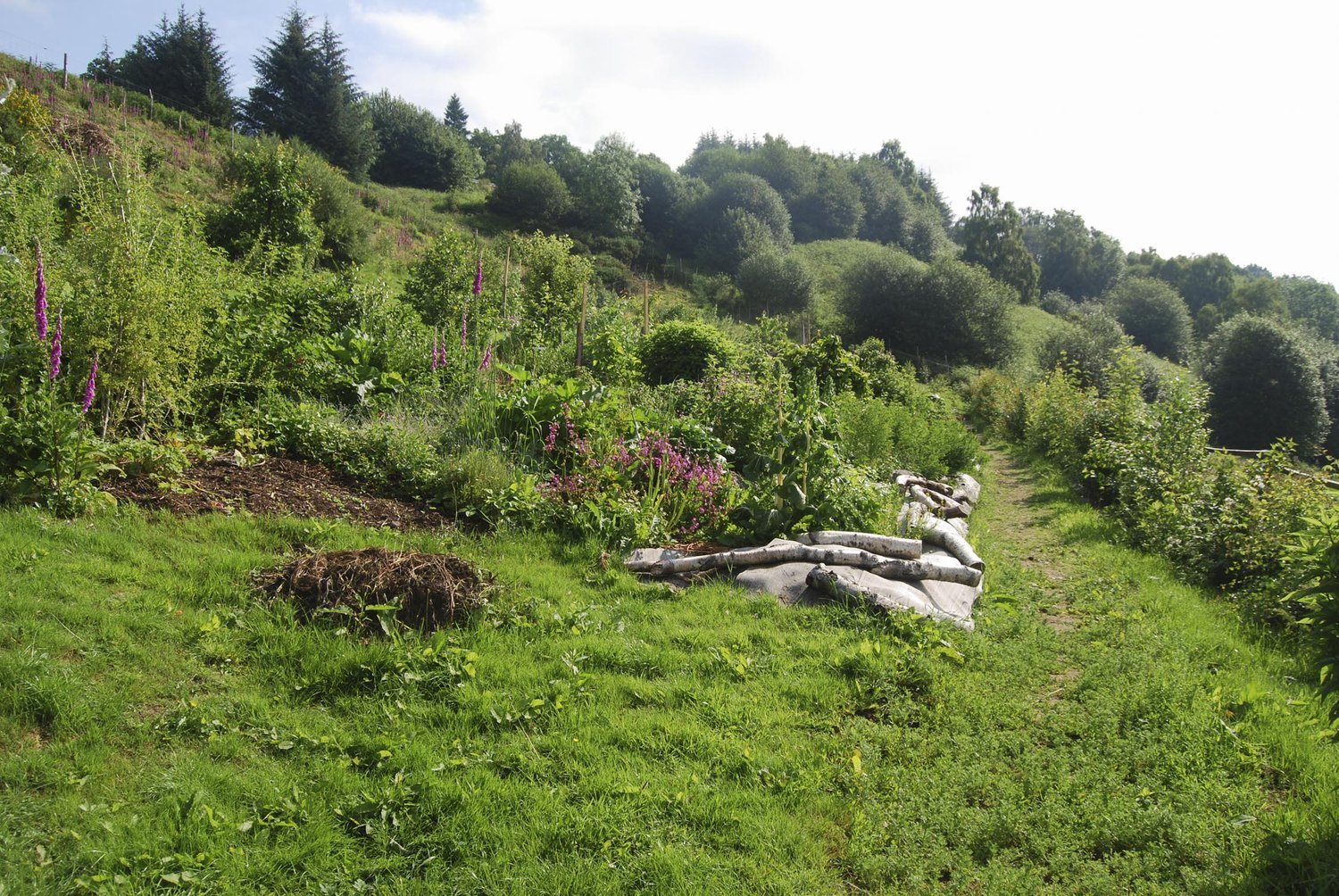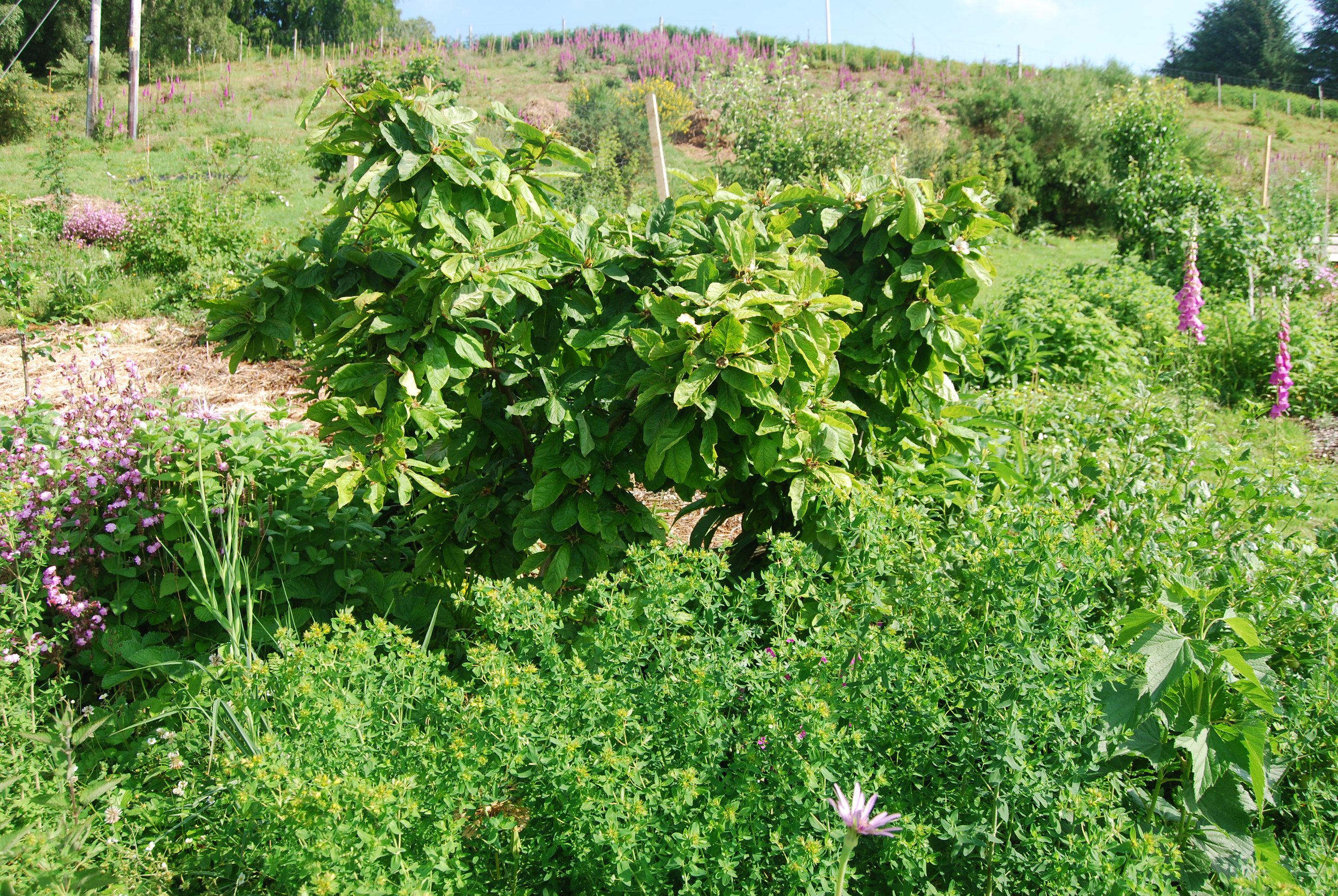Food forest establishment at Bunloit
Resilient food production that strengthens ecosystem services.
Daniel Holm, a Highlands Rewilding ranger, describes how this relatively unknown agroforestry practice can help small areas of land produce a high diversity of high value crops, discussing the heritage fruit and nut varieties chosen for establishment on a Highland estate.
A food forest is a perennial intercropping system using a diverse mix of trees, shrubs, vines, herbs, tubers, mushrooms and annuals. Once mature it can also incorporate animals. The structure of a food forest with all of these layers simulates that of a natural forest and as such, provides the same ecosystem services as a forest.
For an introduction to food forests, see Daniel's first blog, Food Forests: A Resilient Solution for People and Wildlife
Having begun our food forest planting at Bunloit last year, we are now into our second year of planting and mulching, extending the food forest area to approximately 1.5 acres. This small area showcases a method of local, carbon-negative food production, promoting biodiversity while building soils. It is also a much more resilient method of food production in that you are not reliant on just one crop - a great bonus in our ever more erratic climate.
From this month, students from the local Glen Urquhart school will begin helping with the planting of the food forest saplings
Daniel working in the tree nursery at Bunloit. Though we have plans to revive some of the ruined buildings on the estate., this one would require a lot of work to get it to a habitable condition. Currently, rather than see it not used, it provides a perfect place to shelter the tree forest saplings and other young plants. To the right are some fruit and nut saplings, destined for the food forest.
Choosing the site
The area chosen for planting had been used to stack the timber from our Sitka Spruce plantations which were felled last year. The frequent action of the forwarders moving back and forth did quite a lot of damage to the soil in this small area, causing compaction and erosion.
Heavy mulching (loose coverings of material, often cardboard and woodchips, placed on the surface of soil) to prepare the ground for the food forest helps to solve these erosion problems, as well as boost the soil biodiversity. Deep rooted perennial plants and trees will then break up the compaction, restoring the soil structure over time. Going from a degraded site to a productive food producing, carbon-storing, biodiversity-supporting system.
This site was also chosen for its proximity to the farm buildings and a good road, aiding ease of access for maintenance and harvesting of the garden. Its position on a south facing slope and the potential to use some of the south and west facing walls of the farm buildings to grow more fragile fruits such as apricots, also contributed to choosing this site.
Lastly, this site also has relatively deep soil compared to much of the rest of the estate.
Choice of Trees
This year we are adding 39 large fruit and nut trees to the garden. We have chosen varieties that will do well in a northern location which is often wet and cold, along with an assortment of soft fruits, nitrogen fixers and nutrient-accumulating plants such as comfrey.
Some examples of the larger fruit trees we have chosen are:
Apples:
Coul Bush. An eating apple from Ross-shire that originated in Coul in 1827. Selected for the conditions of the northeast, it is well suited to our location. It produces apples with a sweet and creamy flesh which also makes a good sauce. It is also quite a vigorous tree, good for our short growing season.
Katy. This is a very hardy variety originating from Balsgrad in Sweden in 1947. This variety has very good disease resistance, is fairly vigorous, and is a good pollinator of other varieties. It is also known to have blossom that can stand the frost better than most apples, making it a good choice for Bunloit.
Sam Young. Also known as Irish Russet, originating in Kilkenny Ireland. This variety is well suited to our wet conditions here in the north. It produces apples with intense sweet and sharp flavours and good disease resistance. Although the apples may not be the prettiest, as they are prone to cracking, the flavour more than makes up for it.
Cherries:
Cariad. A Welsh variety of cherry bred to cope well in wet conditions. It has good resistance to bacterial canker, and its fruits do not split as frequently during wet years. The fruits manage to ripen well even in less than sunny conditions.
Damsons:
Shropshire Prune: Apparently the best of all the Damsons in wet conditions. They produce small fruits which are too astringent for most to be eaten raw, but once cooked, they are delicious and can be used in all sorts of culinary creations.
Plums
Victoria: A variety which does very well in this part of the world and one I have fond memories of scrumping. Probably the most commonly grown plum in the Highlands because it does so well here. It is relatively disease resistant and produces huge crops of large greenish-yellow and red plums with good flavour. Fruits often need to be thinned as they are prone to producing too many and breaking branches under the weight.
Pear
Grey Auchen: An old pear variety long grown in the north of Scotland and one of the finest tasting dessert winter pears there are. Does really well in the harsh conditions of the north, producing large regular crops. In fact, it would appear to be the harsh conditions of the north that give it its great flavour. Those grown further south in more balmy conditions produce larger fruit but they are of poor flavour and the flesh is insipid.
Hazel/ Cobb Nuts
Webb’s Prize Cobb: A vigorous multi-stemmed shrub or small tree that produces heavy crops of good sized hazelnuts, especially if other hazels are nearby for pollination. Hazels grow well at Bunloit and we have some great examples of very old hazels which had previously been coppiced. I grow this variety at home in my own forest garden and it has done well so far so it seemed like an obvious choice for Bunloit.
Soft fruits and species diversity
Along with the fruit trees we will plant this winter/spring, we will also plant 50 soft fruit bushes. Several varieties of black currant, red currant, gooseberry and raspberry. All plants propagated from my own forest garden and so are varieties I know will do well at Bunloit. As well as adding to the diversity of crops that will come from the garden, these plants will increase the diversity of its structure, giving it a more natural woodland look with many plants of different heights and growth habits. In addition, this increases the forest garden's potential to act as a habitat for more species of bird, insect fungi etc.
This diversity of crops also plays to the saying of not putting all your eggs in one basket. The more diverse the garden is, the more resilient it is to pests, extremes of climate or changing markets.
One example of the benefits of increased crop diversity I have found in my own forest garden is that the black birds much prefer red currents over cherries. So the red currents act as a sacrificial crop to nature and I still get more than I need as they are so productive, and I never have to net my cherries.
In the future, further layers of woodland structure will be added - ground cover plants like strawberries, herbs such as marjoram and mint, tall canopy trees like pecans or walnut and climbers such as kiwis, grapes and hops. Eventually, the structure will resemble much more of a natural woodland than a traditional orchard.
Hedging and protection
Individual tree protection, constructed from old fence posts, from across the estate
We are this year planting 180m of hedging around the forest garden to provide shelter from the often windy conditions at Bunloit. Preventing the loss of blossom and fruits during windy days and protecting plants and trees from more serious wind damage.
The hedge consists of native tree species, hazel, dog rose, hawthorn, blackthorn, bird cherry and crab apple. Once established, alongside its wind protection, it will also provide an important habitat and food source for wildlife. This, in turn, will help with the productivity of the food forest through increased pollination and predation of insects which may cause problems if left unchecked.
Once established, the hedge will provide a significant amount of leaf mulch to the garden in the autumn, increasing soil organic matter, water retention, carbon storage and soil biodiversity. The plants and trees of the forest garden will also provide a large quantity of leaf mulch and woody debris with the same benefits to the soil.
We are further protecting the site from damage by large herbivores, such as our cattle and deer, by electric fencing the perimeter to stop the cows from entering. And each of the new fruit and nut trees are having their own individual protections put around them, constructed from the old fence posts we are removing from all over the estate, and getting one more use out of them.
Each fruit and nut tree will be sheet mulched around with cardboard and then wood chip generated on the estate from non native tree removal. This should help to establish the young trees by removing weed competition for the first couple of years. In addition, the mulch will retain soil moisture, maintaining steady soil water levels. A constant supply of soil moisture results in much better establishment, preventing the stressing of a young tree going from wet to dry to wet again. The carboard and wood chip will eventually break down and become part of the soil, building its structure, adding nutrients and carbon, and supporting soil biodiversity.
All of this year's activity really sets out the area of the forest garden. With a little use of your imagination, you can see it 4 or 5 years down the line producing a considerable diversity of unique and tasty foods, which could be for sale in the local area or for guests and visitors to the estate to harvest themselves.
The site will have been transformed from a relatively unproductive and degraded piece of land to something which enhances biodiversity and produces local food whilst also storing carbon and being aesthetically pleasing.
If you would like to know how to start your own food forest, Daniel has written a step by step guide on how to start your own: Starting Your Own Food Forest
Pictures of Daniel’s older and more established food forest at home.



